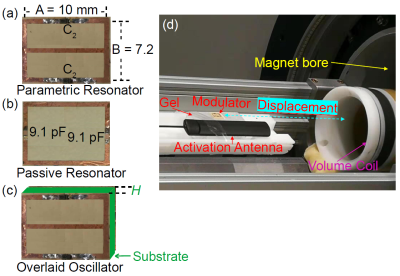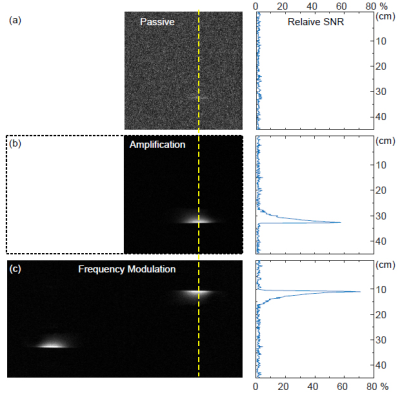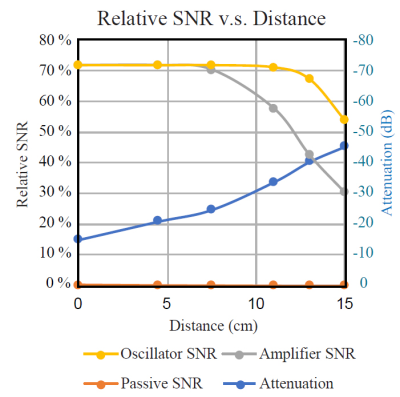4275
Wireless Powered Frequency Encoding of Locally Detected MR Images for Remote Signal Transmission1Michigan State University, East Lansing, MI, United States
Synopsis
With a compact and batteryless design, the wireless powered parametric oscillator can simultaneously down-convert and frequency encode locally detected MR signals, and wirelessly transmit them to remotely coupled external receivers, thus maintaining superior sensitivity of localized detectors over larger distance separations.
Introduction
Wireless signal transmission is advantageous to improve operation flexibility of MRI. Although inductive coupling is often used for this purpose, it is effective only within the near field region. For communications beyond the near field, RF signals can be down converted to the MHz range (1) before being digitized to modulate a GHz carrier. Alternatively, they can be directly digitized and encoded onto carriers waves with increasingly higher frequencies, from millimeter (2) to optical (3) range. These multi-stage schemes require complicated circuits with large power consumption, unsuitable for long-term operation inside confined cavities. To overcome these limitations, we constructed a wirelessly powered frequency modulator that could combine down conversion and signal encoding into a single stage, thus significantly simplifying the design of wireless coils for improved sensitivity of implantable or interventional MRI.Methods
The core component of this wireless modulator was a double-frequency parametric resonator (Fig. 1a) whose second resonance mode was created by bridging the virtual voltage grounds of its first resonance mode. The double-frequency parametric resonator was coaxially overlaid with another single frequency resonator (Fig. 1b) to create a third resonance mode. By properly adjusting the substrate thickness between these two resonators (Fig. 1c), the third resonance frequency was tuned to approximately the sum of two lower resonance frequencies. When activated by a pumping field near the highest resonance frequency, the coupled resonator pair could utilize its nonlinear capacitance to convert wireless pumping power into oscillation currents circulating near its two lower resonance frequencies. In the presence of an input RF signal slightly deviated from the oscillation signal by an offset frequency, the oscillation signal was frequency modulated by the input signal to create multiple sidebands separated by the offset frequency. As a result, this frequency modulated oscillation signal could be utilized to transmit locally detected MRI signals with improved sensitivity over large distance separations (Fig. 1d), until the oscillation signal was detected by an external volume coil that was interfaced with a conventional MRI scanner. After frequency demodulation of the received oscillation signal, MR images can be reconstructed from 2D Fourier transform.Results
When the modulator was placed on top of a 1% agarose phantom and inserted into the center of a 7T scanner, the volume coil was displaced by 11-cm distance from the center of magnet to emulate weak coupling condition. To estimate the magnitude of transmission attenuation, an MR image (Fig. 2a) was first reconstructed from signals that were passively relayed to the volume coil, using FOV 45 x 45 mm2, acquisition matrix 256 x 256, bandwidth 50 kHz, excitation angle 5 deg, TR/TE 20/10 ms. Compared to a surface coil with the same dimension but with wired connections to scanner, the passively coupled modulator had a relative SNR of only ~2%, corresponding to 34-dB (or 50-fold) transmission attenuation. Subsequently, we turned on pumping signal and set its power level about 0.1 dBm below the oscillation threshold to enable stable amplification with high gain (33 dB), leading to significantly improved SNR (Fig. 2b), owing to regenerative amplification of MR signals by parametric mixing (4-7). Finally, we increased the pumping power above the oscillation threshold and recorded the oscillation signal at doubled sampling rate, obtaining enlarged horizontal field-of-view (Fig. 2c). By overlapping the oscillation frequency to the center of the enlarged FOV, time-domain MR signals were retrieved by derivatizing the phase angle, before being Fourier Transformed to obtain the 2D image. Compared to the image obtained by regenerative amplification (Fig. 2b), the image obtained by FM encoding was 24% more sensitive, demonstrating the better noise immunity of FM encoding. Fig. 2c contained a center-symmetric mirror of the original object, due to the cosine-encoding relation of the message signal in both dimensions.To estimate the modulator’s effective operation distance, the volume coil was gradually moved away from the modulator. For each distance separation, the excitation power on the volume coil was proportionally scaled to maintain the same effective excitation angle. According to Fig. 3, both the amplifier and the modulator had similar SNR when the transmission attenuation was smaller than 21 dB. But the modulator could maintain constant sensitivity for up to 34-dB attenuation when the modulator already laid outside the volume coil. Even though the modulator’s sensitivity would eventually drop under very large distance separations, its SNR always remained higher than parametric amplification, demonstrating the advantage of FM encoding.
Conclusion
A wirelessly powered parametric oscillator is constructed for simultaneous down-conversion and frequency-encoding of MR signals at their offset frequencies from the oscillation signal. Without the need for DC power or multi-stage processors, this compact circuit can detect, encode and broadcast locally acquired MR signals over larger distance separations, using <9 dBm of pumping power. It can wirelessly communicate with any conventional detectors that are readily available on ordinary MRI scanners, thus greatly improving MRI’s applicability for any parts of body without the need for dedicated focal coils using specialized signal interfaces. Although frequency encoding of MR signals is somewhat noisier than a directly connected surface coil, the greatly improved flexibility of this wireless modulator will justify its use inside confined space or body cavities.Acknowledgements
This work was supported in part by the National Institutes of Health under Grant R00EB016753.References
1. Wei J, Liu Z, Chai Z, et al. A realization of digital wireless transmission for MRI signals based on 802.11b. J Magn Reson 2007;186(2):358-363.
2. Aggarwal K, Joshi KR, Rajavi Y, et al. A Millimeter-Wave Digital Link for Wireless MRI. IEEE transactions on medical imaging 2017;36(2):574-583.
3. Sporrer B, Wu LB, Bettini L, et al. A Fully Integrated Dual-Channel On-Coil CMOS Receiver for Array Coils in 1.5-10.5 T MRI. Ieee Transactions on Biomedical Circuits and Systems 2017;11(6):1245-1255.
4. Cork P, Hulbert AP, Hunt J. Parametric Amplifier Device. US Patent 2014:8638102 B8638102.
5. Reykowski A. System and method for a mode balanced parametric amplifier. US Patent 2015:9207292B9207292.
6. Zeng XC, Ma ST, Kruger JM, et al. High-resolution MRI of kidney microstructures at 7.05 T with an endo-colonic Wireless Amplified NMR detector. Journal of Magnetic Resonance 2019;303:121-127.
7. Syms RRA, Floume T, Young IR, et al. Parametric Amplification of Magnetic Resonance Images. Ieee Sens J 2012;12(6):1836-1845.
Figures


